Bundesliga giants Bayern Munich face La Liga side, Sevilla, in this year’s edition of UEFA Super Cup which will be held on Thursday, 24 September 20 at Puskás Aréna, Budapest, Hungary. The 2019/20 Champions League winners are big favourites to win the match and add another trophy to their collection but the Europa League champions will be keen to cause an upset.
Prior to tomorrow’s clash, Bayern have met Sevilla twice – in the quarter-finals of the 2017/18 UEFA Champions League for exact. Both teams drew in the first leg but Bayern managed to go through the tie with a 1-2 win at Sevilla’s Stadion Ramón Sánchez Pizjuán.
We’ll take a closer look at how both teams may play and what sort of tactics and intrigue we will see tomorrow in this tactical analysis.
Predicted lineups
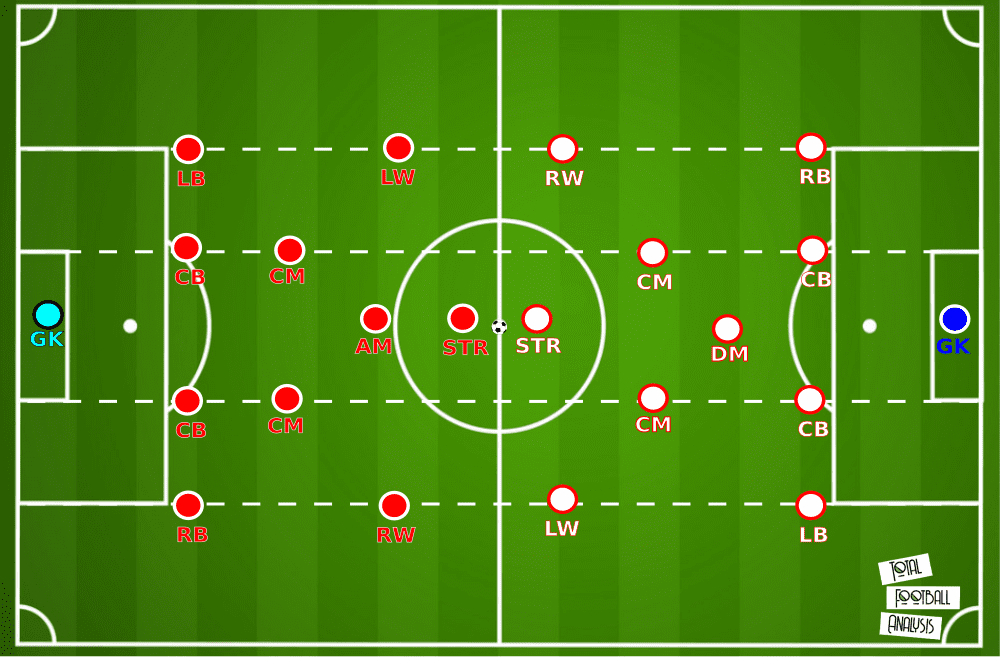
Bayern Munich (4-2-3-1)
Starting XI: Neuer – Pavard, Süle, Boateng, Davies – Kimmich, Goretzka – Sané, Müller, Gnabry – Lewandowski
Sevilla (4-3-3)
Starting XI: Bono – Navas, Koundé, Diego Carlos, Escudero – , Fernando, Jordán, Rakitic – Suso, de Jong, Ocampos
Hans-Dieter Flick will be expected to deploy his team tomorrow in his favoured 4-2-3-1 formation. There is not much change to be expected in terms of personnel after thrashing Schalke 8-0 in their previous match. David Alaba is doubtful but may return – albeit not in the starting lineup – if he passed the fitness test. Alphonso Davies was an unused substitute in the match against Schalke and may start at the expense of Lucas Hernandez.
With Thiago leaving for Liverpool, Joshua Kimmich would be expected to partner up with Leon Goretzka in the middle of the field while Benjamin Pavard slots in at right-back.
Kingsley Coman is a doubt for this game after missing out in the previous match due to COVID-19 but Leroy Sané will be a more-than-capable starter. The former Manchester City winger is predicted to start as a right-winger while former Arsenal man Serge Gnabry fills in the left-winger spot, allowing both to cut inside with more ease and comfort.
As usual, Thomas Müller plays as a free-roaming attacking midfielder while Robert Lewandowski leads the attacking line.
Unlike Bayern, Sevilla comes with a clean bill of health.
Former Spain and Real Madrid manager Julen Lopetegui may start with a 4-3-3 formation in the next game.
Bono will be expected to start as the goalkeeper tomorrow, ahead of Tomáš Vaclík. Meanwhile, Jules Koundé, who is rumoured to be tracked by Manchester City, is expected to start tomorrow, partnering with Diego Carlos at the heart of the defence. Meanwhile, experienced wide man Jesús Navas is predicted to start as a right-back whilst Sergio Escudero slots in at left-back. Argentine footballer Marcos Acuña may also start as a left-back.
New signing Ivan Rakitic is expected to slot straight into midfield, playing as a left central midfielder while Joan Jordán fills in the right side of centre-midfield and Fernando Reges sitting at the bottom of the three-man midfield.
As usual, Suso, Luuk de Jong, and Lucas Ocampos will be expected to feature as the attacking trident.
Sevilla utilising width and Bayern’s aggressive pressure
Bayern are known to be a high-pressing team. Lewandowski and co. usually presses high right when the opposing team starts their build-up or in a goal-kick situation.
Meanwhile, Sevilla are a team that tend to build their play up from the back and look to utilise width to stretch the opposing team’s structure to create vertical gaps or just simply to create chances through crosses from wide areas.
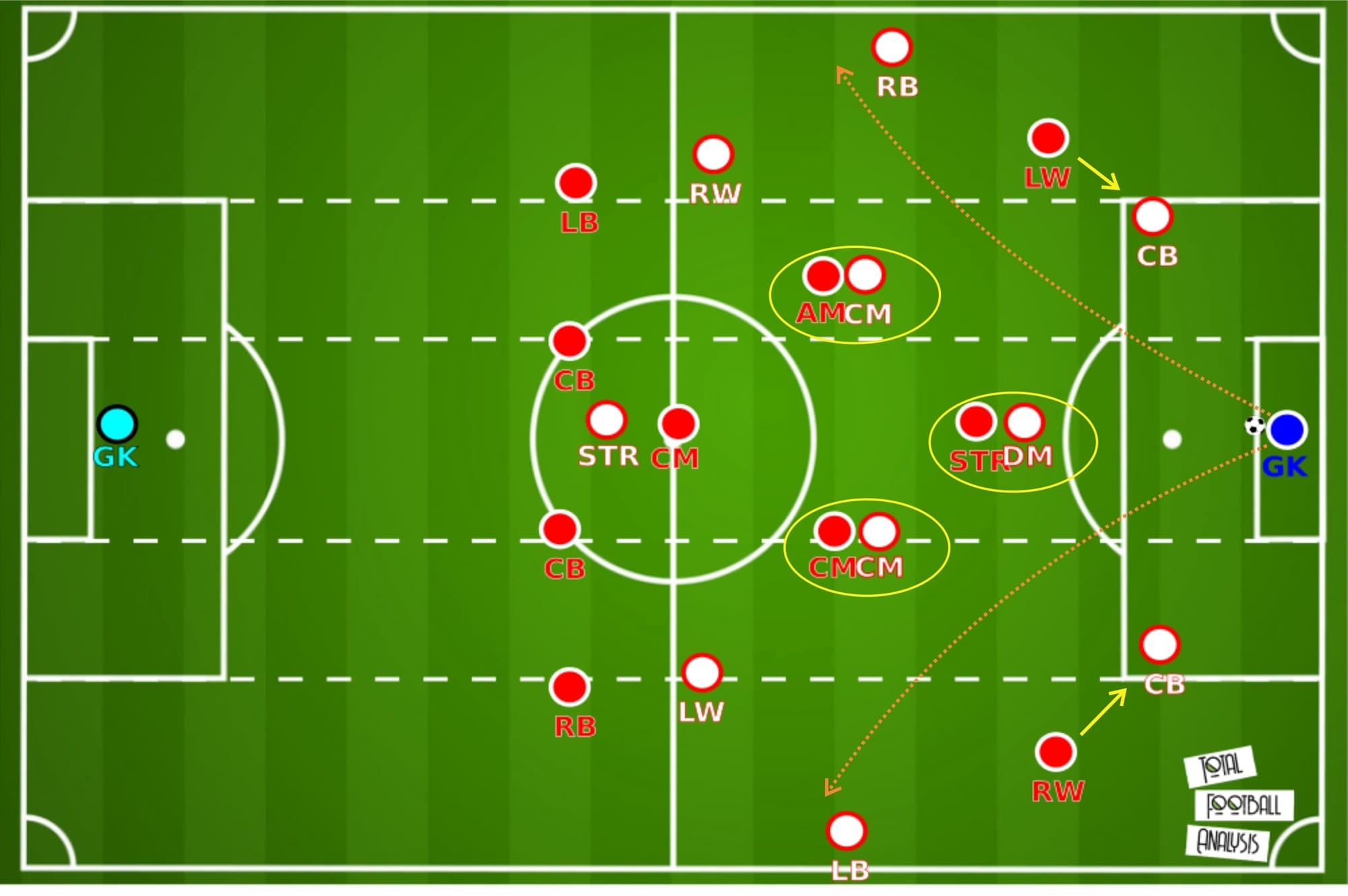
Above you can see how Bayern (red kit) may press Sevilla (white kit) in the build-up. Sevilla usually start with a short build-up with the goalkeeper preferring to play the ball to either centre-back. The defensive midfielder usually stays deep to create a diamond-like shape at the back while both central midfielders usually staying slightly higher. Both full-backs sit high and wide, stretching the defensive structure.
Sevilla don’t seem to have a tendency to create a back-three in the build-up preferring to stick with two centre-backs but they rely on the flexibility of the midfielders in front of them. The three midfielders actively move around: dropping deep or pushing high, sometimes drifting wide as well to open passing lanes and angles.
Meanwhile, Bayern tend to create the shape as seen in the image above when pressing. Bayern are mainly man-oriented in their approach but they are not strictly man-oriented. They also use a bit of space/zonal defending in their approach with some players usually defending against a man but also covering passing lane and some others usually purposely leaving an opponent free with the intention of inviting a pass towards that particular opponent.
They simulate a pincer when pressing with both wingers looking to press the Sevilla centre-backs while closing down their passing lanes to the full-backs. These wingers defend both space and man. They don’t necessarily stick close to either the opposing full-back or centre-back, but immediately presses if the ball is played to either of them.
Meanwhile, as you can see in the image above, all three Sevilla midfielders will be man-marked by Bayern’s players making central progression highly difficult and risky for Sevilla.
Though Sevilla also have strong, tall strikers who can win aerial duels and lay the ball off towards a teammate, Bayern may be able to quickly press or win the second ball to regain possession due to their sound defensive structure as well as aggression, so long goalkeeper distributions towards the target man may also not be ideal.
The ideal way to escape this pressure seems to be by playing directly to the full-backs as indicated with the orange arrows above.
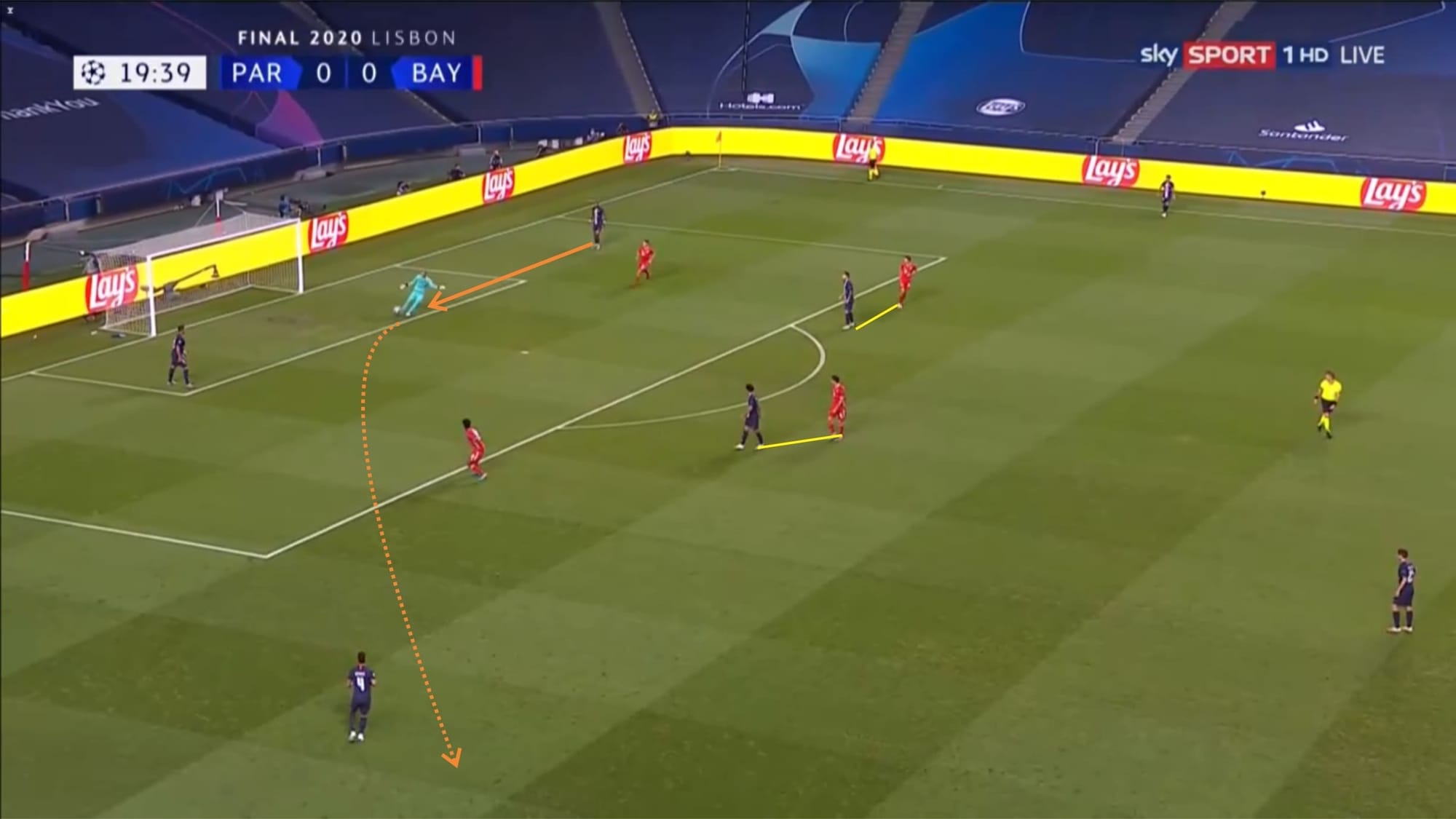
Above is the example of Bayern’s press in their match against Paris Saint-Germain. As you can see above, the pincer press was in action with the right-winger of Bayern closing down the ball carrier whilst blocking the passing lane towards wide areas. PSG were using a double pivot in this match and above you can see that Müller still followed the PSG central midfielder and marked him closely. Meanwhile, left-winger Coman was standing in between the opposing right centre-back and right-back looking to anticipate a pass towards either opponent. As you can see, Coman already read the PSG goalkeeper’s intention and quickly closed down the right-back.
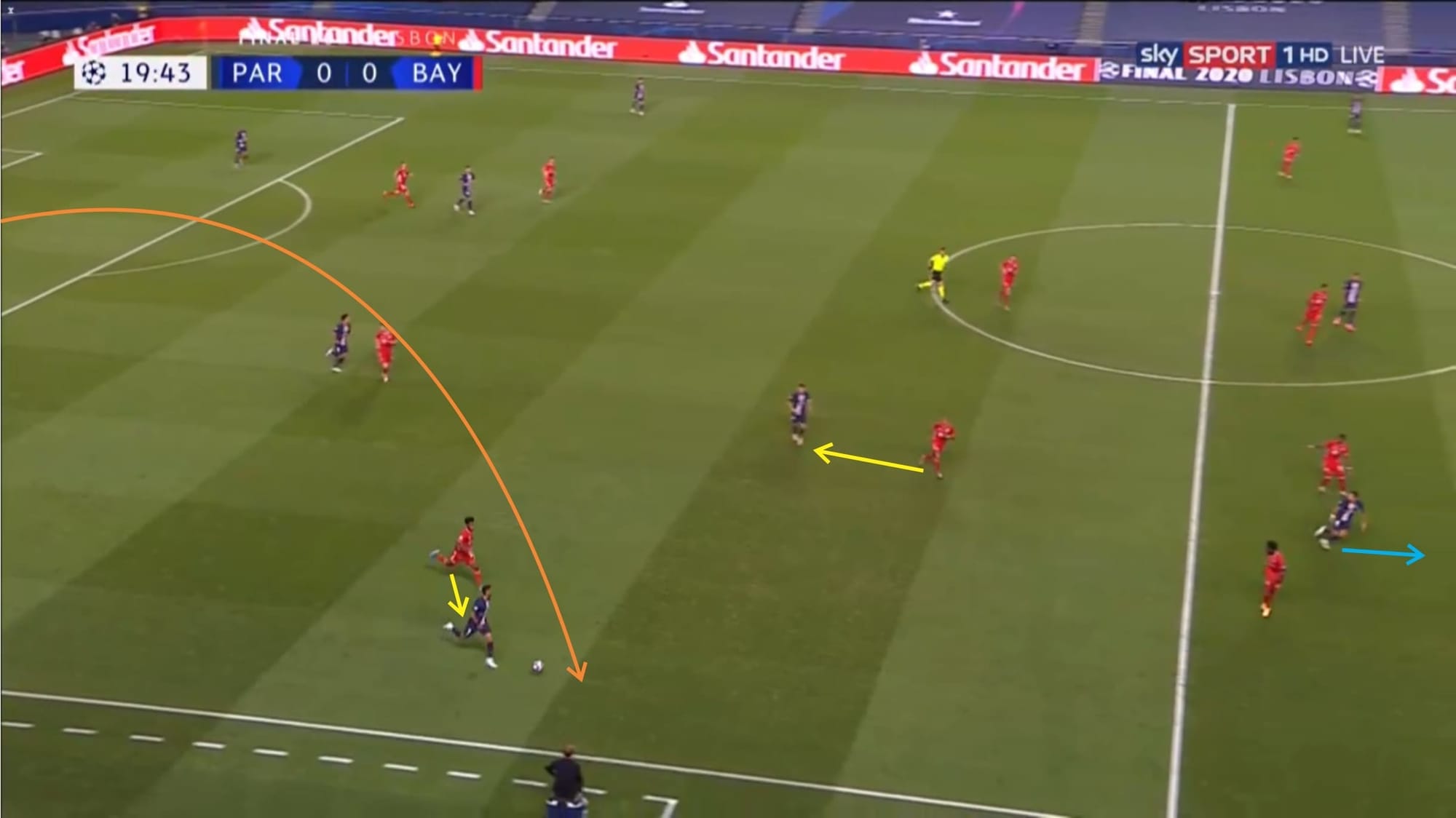
The PSG right-back managed to receive a pass but quickly found himself with no good passing options nearby as Bayern quickly shifted their block towards the flank and successfully closed down any passing lanes as well as setting up an offside trap. The PSG right-back – who was chased down by the explosive Coman – lost his composure and rushed his decision, playing a pass towards and offside teammate.
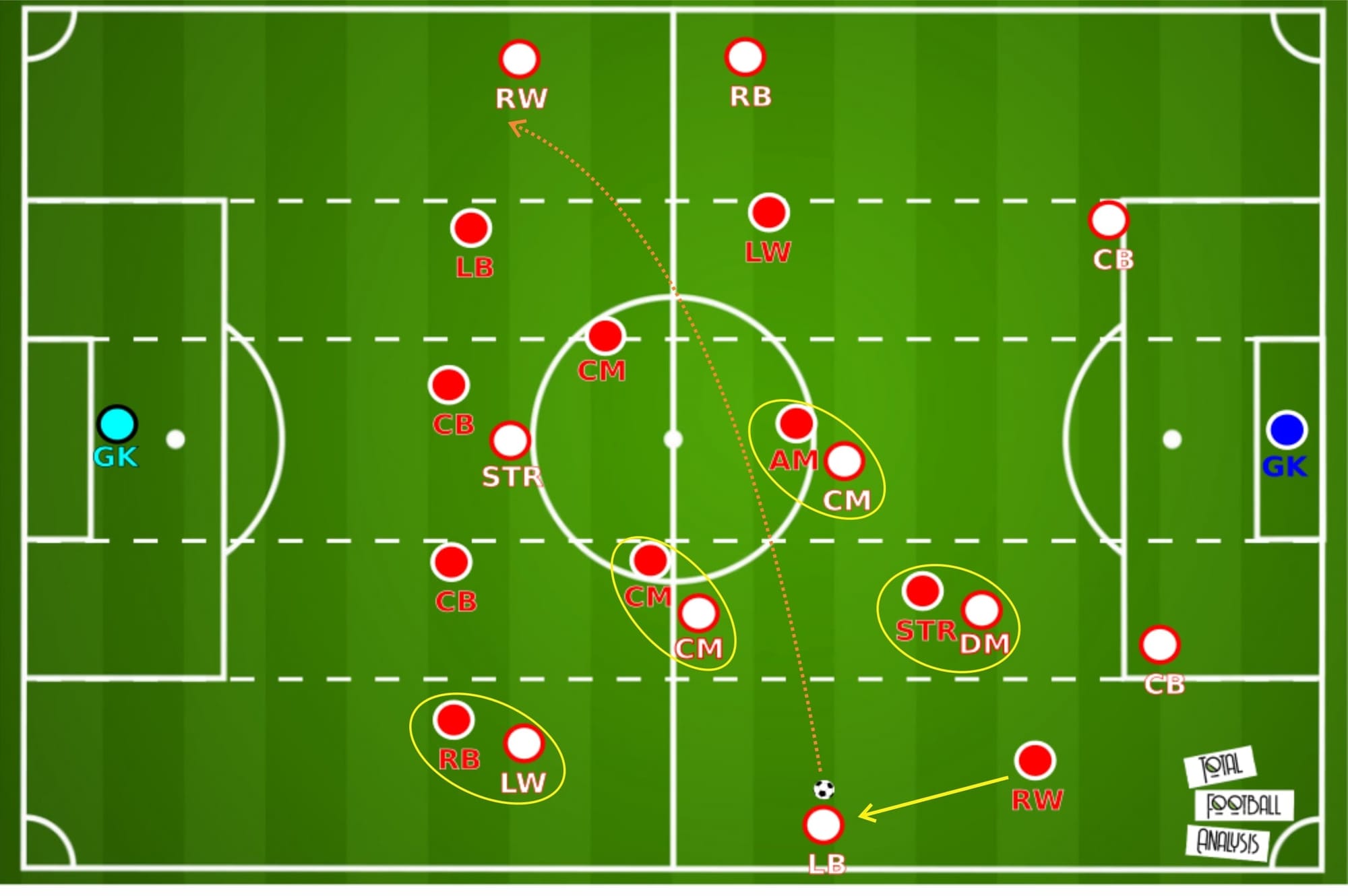
The same kind of situation may also happen to Sevilla if they’re not playing smartly and carefully. As you can see above, Bayern will aim to overload the strong side and they will look to use a combination of man-marking and closing down passing lanes to isolate the ball-carrier. For Sevilla, it might be better to have the nearby options move closer to invite pressure but also keep the weak side players high and wide so they can be available for a crossfield pass.
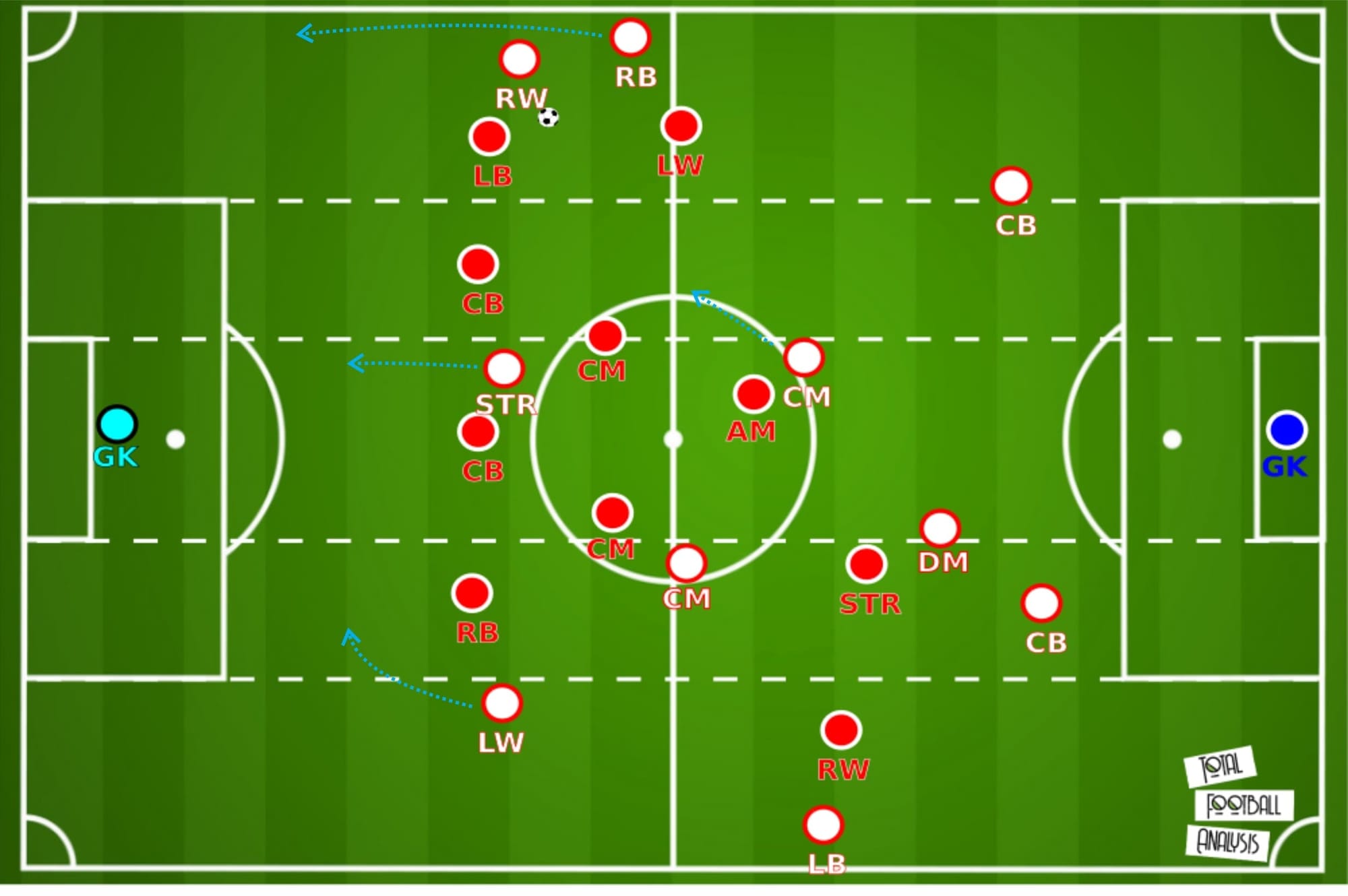
Once the ball is switched to the underloaded area, Sevilla’s full-back can make an attacking run and exploit the space on the flank while the striker and the ball-far winger look to get into the box to attack the delivery.
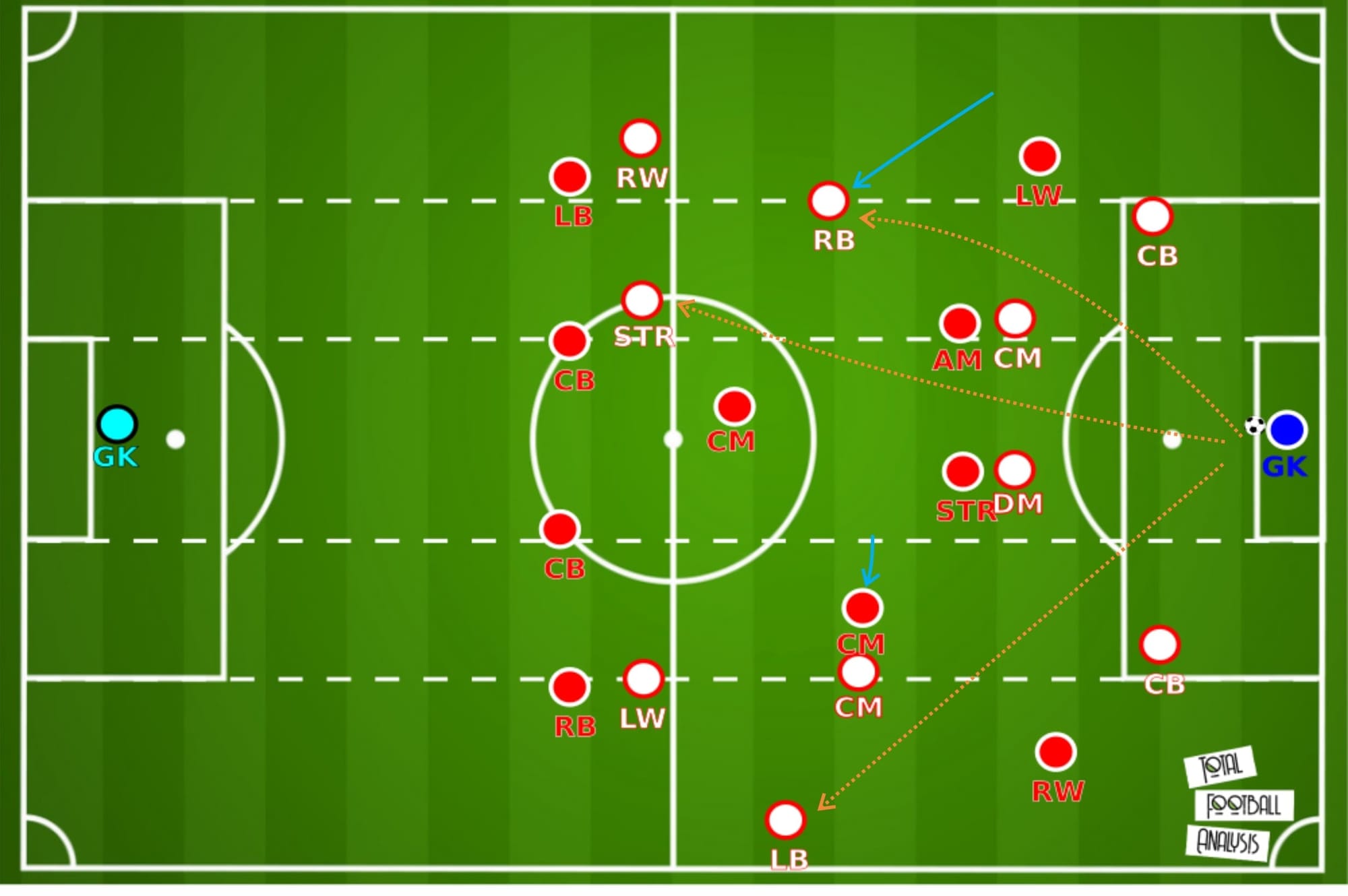
Perhaps another way of building-up/attacking that can be used in the game is as shown in the image above. Sevilla may be able to escape Bayern’s high pressure and attack down the flank by creating overloads on both flanks.
Firstly, you can see that one of Sevilla’s central midfielder drops down, dragging his marker with him and opening up space. On the right side, you can see that the right-back can push forward and move into the half-space, occupying the space that was opened up. Sevilla’s striker also shifted slightly to the right side.
On the left side, you can see the central midfielder moving wide, providing support for the wide men on the left.
By doing so, Sevilla may be able to distribute directly towards either full-back, but as you can see, the right side is more open and they may have more variety of options there. They may be able to distribute towards the target man, so he can lay the ball off onto the unmarked right-back or the goalkeeper can just directly loft a pass towards the right-back.
With Sevilla tending to attack down the flanks and Bayern tending to set-up pressing traps in central areas, it might be safer and easier for Sevilla to focus on overloading the flanks rather than having players occupy gaps in central areas.
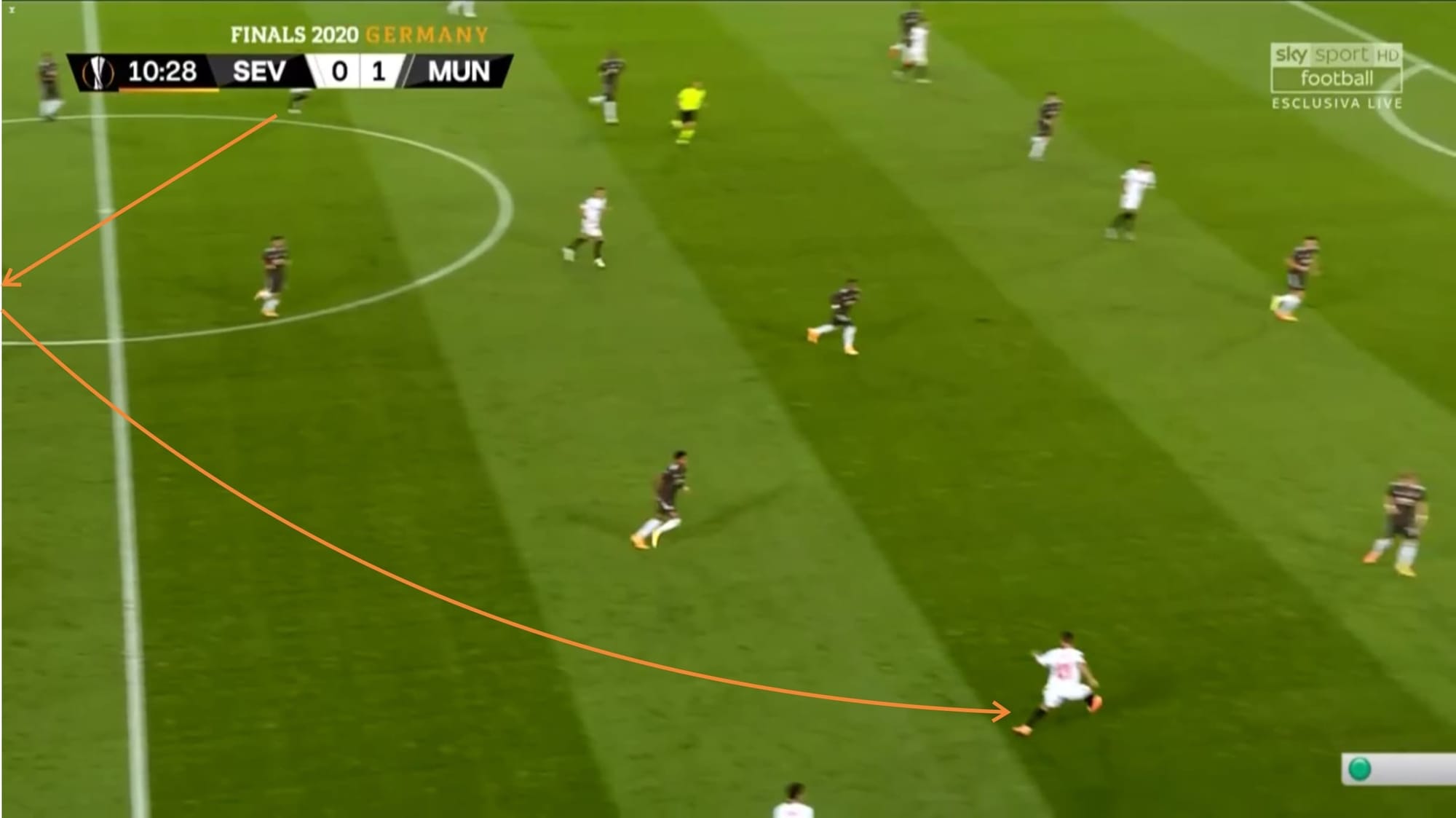
Sevilla may also try to use their u-pattern passing in order to get the ball from one side to the other.
The example above was from their UEFA Europa League match against Manchester United. Above, you can see that Sevilla successfully moved the ball from side to side with a u-pattern passing.
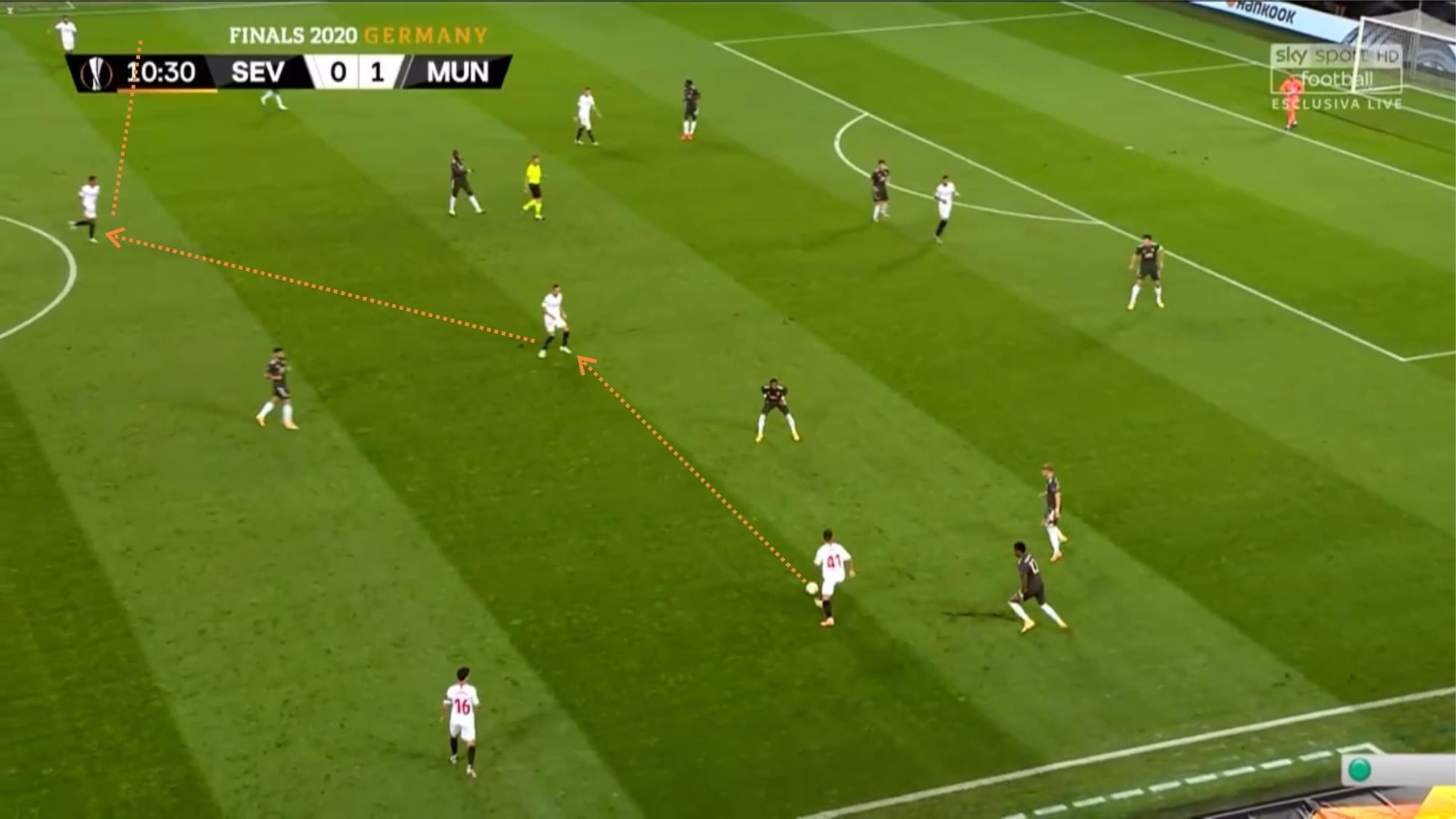
Manchester United were quite vulnerable in this match. They lacked compactness and discipline and horizontal and vertical gaps were easily created by Sevilla as they keep moving the ball from side to side to force United to keep shifting their block. These gaps were easily exploited by Sevilla’s central midfielders as they comfortably moved into open spaces in central areas to link up. Above you can see that Sevilla moved the ball yet again from one side to another.
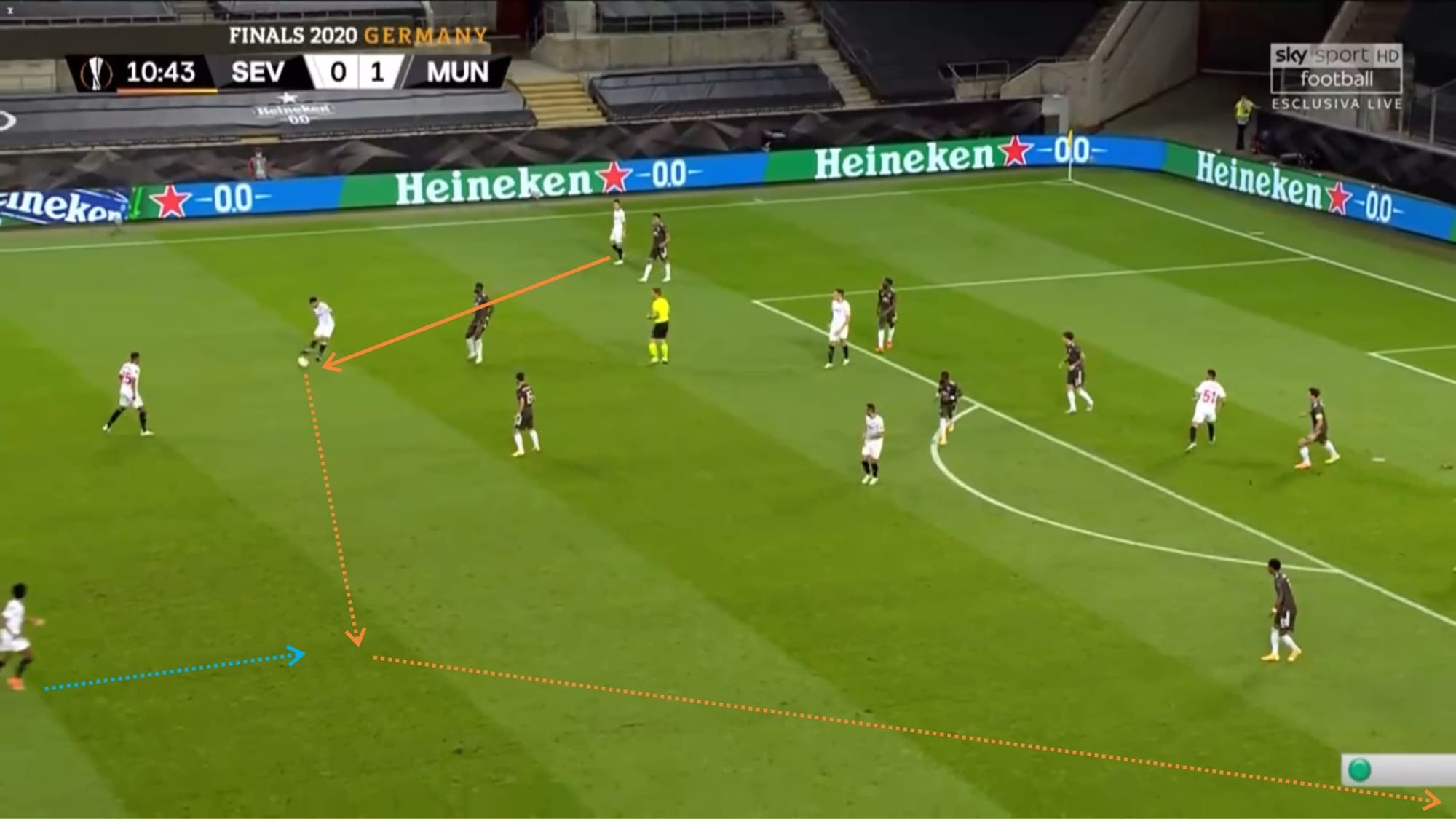
United managed to shift their block across the field to prevent a cross from the left side. However, Sevilla looked to switch the play again towards the opposite flank.
In order to switch play towards the other flank, Sevilla actually seem to do this more often than a direct crossfield ball, but against a highly-disciplined and defensively compact Bayern side, Sevilla might find some trouble doing so.
Lopetegui’s side are quite patient in possession. They tend to move the ball a lot laterally as mentioned earlier in this analysis. Despite that, they don’t necessarily lack penetration. Though they are not as potent in central areas, they can be extremely dangerous in wide areas. They are often able to create a lot of chance from crosses. Last season for example, Sevilla averaged 20 crosses per game, far above the league’s average of 14.46.
Bayern exploiting space between the lines and creating overloads
Sevilla must prepare for Bayern’s attacks tomorrow. Flick’s side are known to be vertical-oriented, very fluid and flexible, and aggressive in attack.

Bayern usually build their play up from the back with the goalkeeper playing the ball towards either centre-back. One of the central midfielders will drop down while the other stays slightly higher. The two full-backs also sit high and wide.
As can be seen above, they tend to create a diamond shape in the build-up, allowing them to rotate possession with more ease. Neuer also very often get involved in the early phase of build-up, allowing them to have a numerical advantage against the opposing team’s first line of pressure.
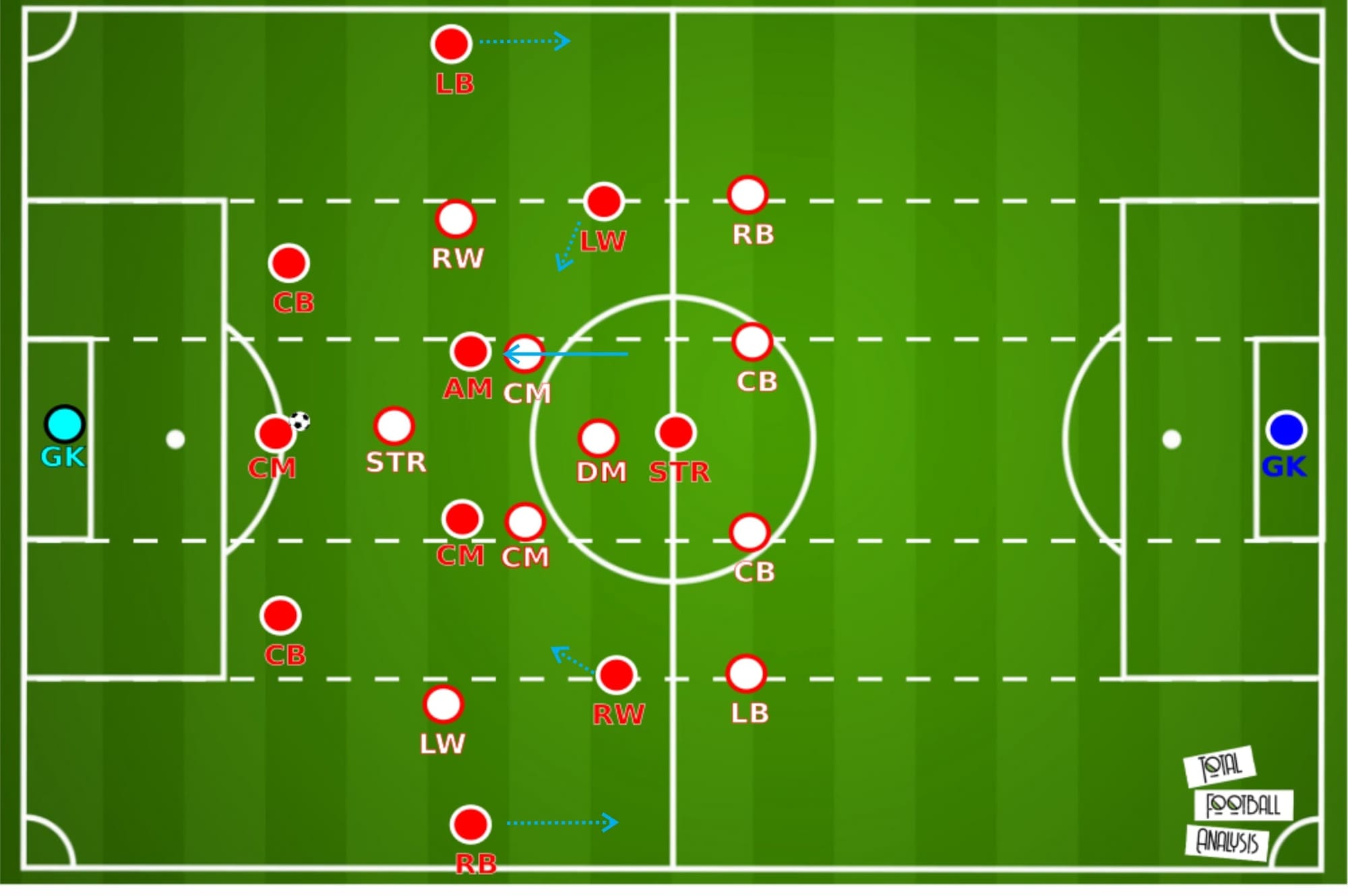
Aside from building-up with two centre-backs, Bayern can sometimes be seen creating a back-three in the early phase of build-up with one of the central midfielders dropping and sitting in between or beside the two centre-backs. As you can see, the attacking midfielder tends to drop deeper to create supporting angles and show for the ball. You can also see above that the wingers tend to occupy the half-spaces and like to float in between the midfield and defensive line of the opposing team. Bayern likes to create 2v1 situations in the half-spaces or on the flanks.
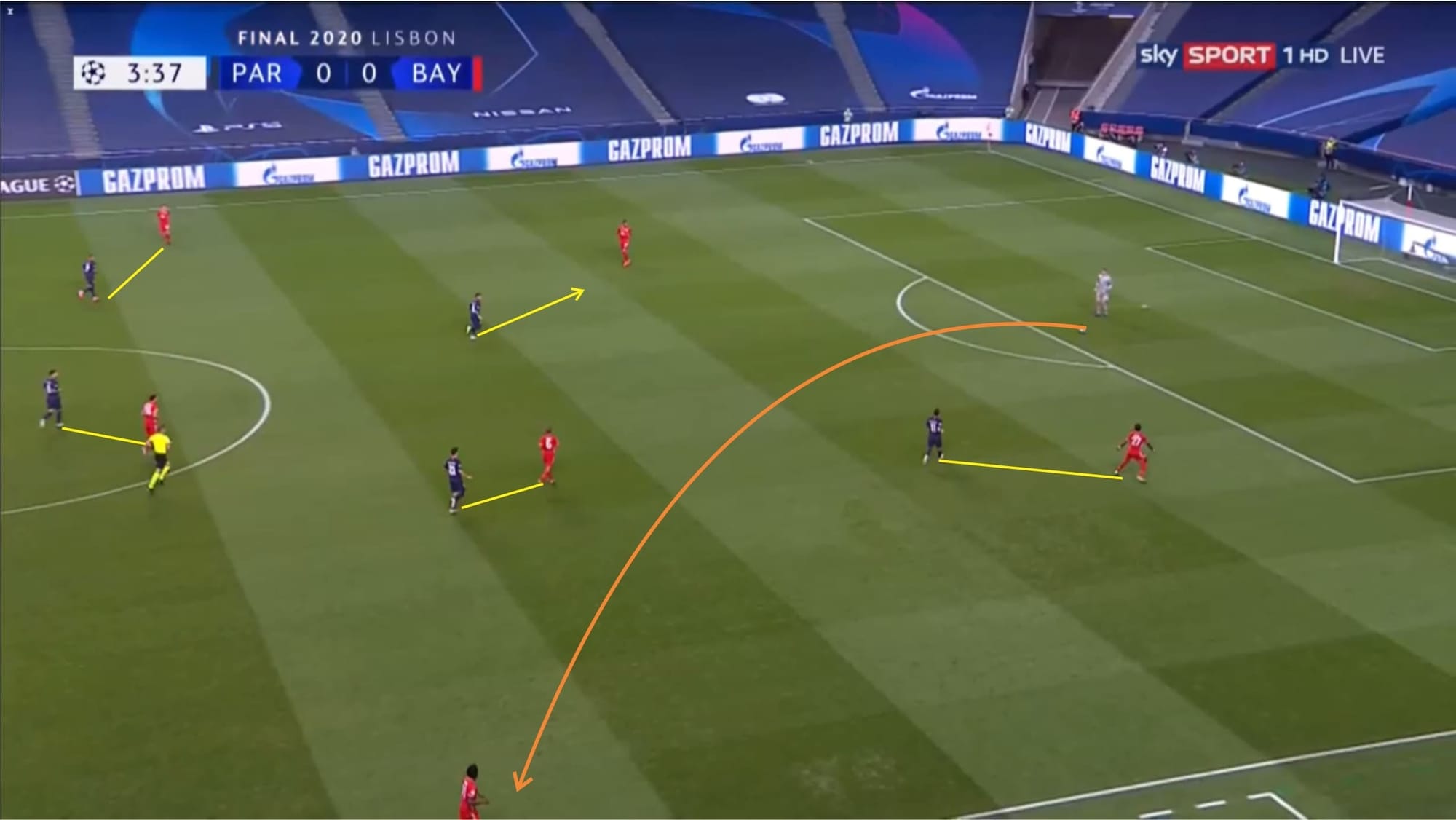
As can be seen above, PSG employed a man-marking approach against Bayern in the build-up. Thomas Tuchel’s side intentionally become asymmetrical in defence but their pressure was easily bypassed by Bayern. With nearby options blocked, Neuer can still access the left-back who was only marked loosely by PSG’s right-back in this game.
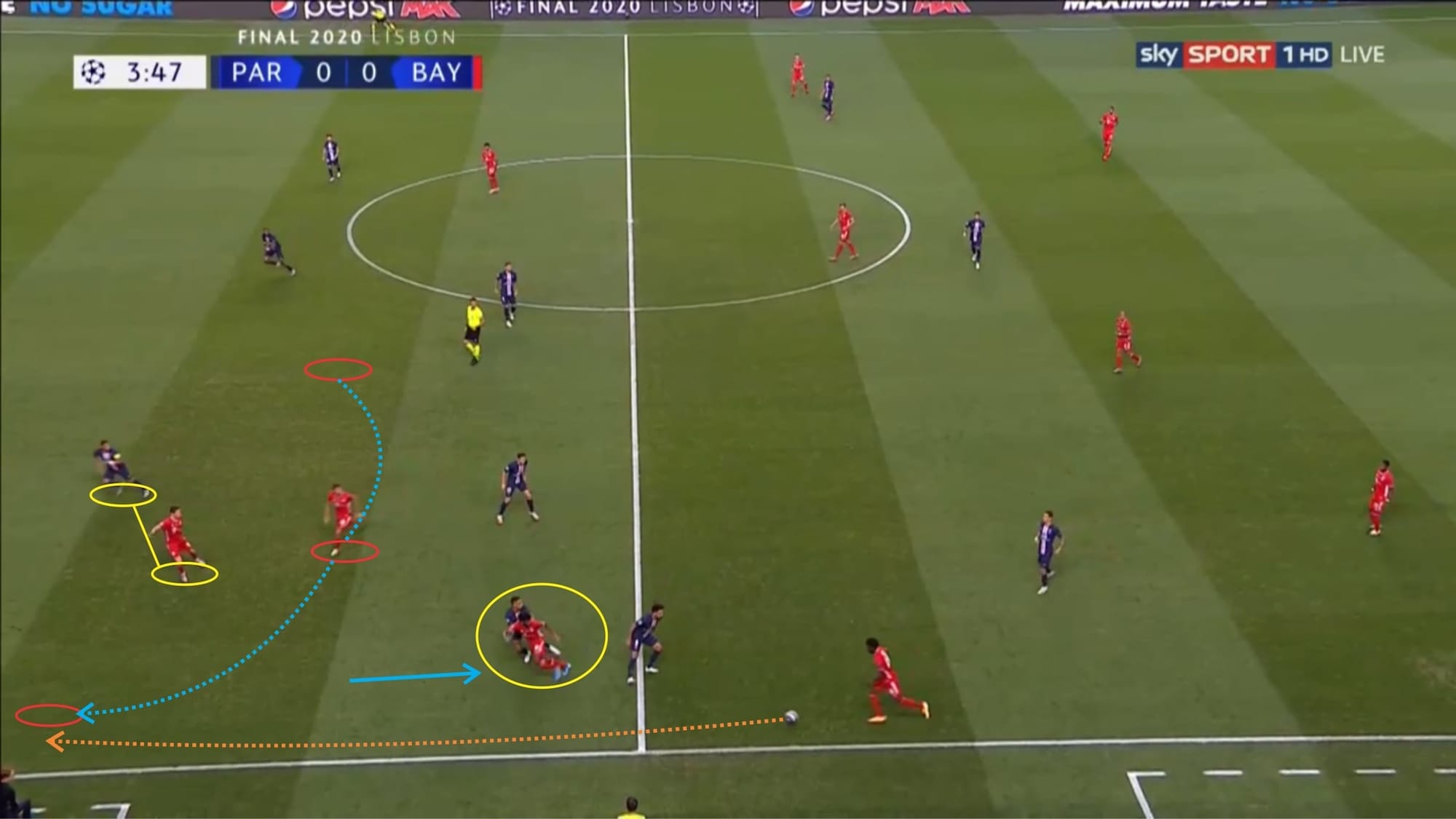
The left-back (Davies) then moved forward with the ball. There are several things that can be seen in the image above. Bayern tend to use flexible and fluid movements to attract pressure/drag opponent out of position to open up passing lanes and angles as can be seen above. Gnabry dropped from his position while dragging Kehrer with him.
Bayern also tend to create attacking overloads in certain areas in order to create numerical advantages. This often causes confusion and dilemmas for the opposing defender, asking questions to them and forcing them to make a decision as to who to close down or who to mark.
Above you can see Lewandowski moving to the left side of the field, occupying Thiago Silva. Instead of making a run into the space, the Polish striker maintained his position, allowing Müller, to make a curved run from central areas into the space that was created on the flank.
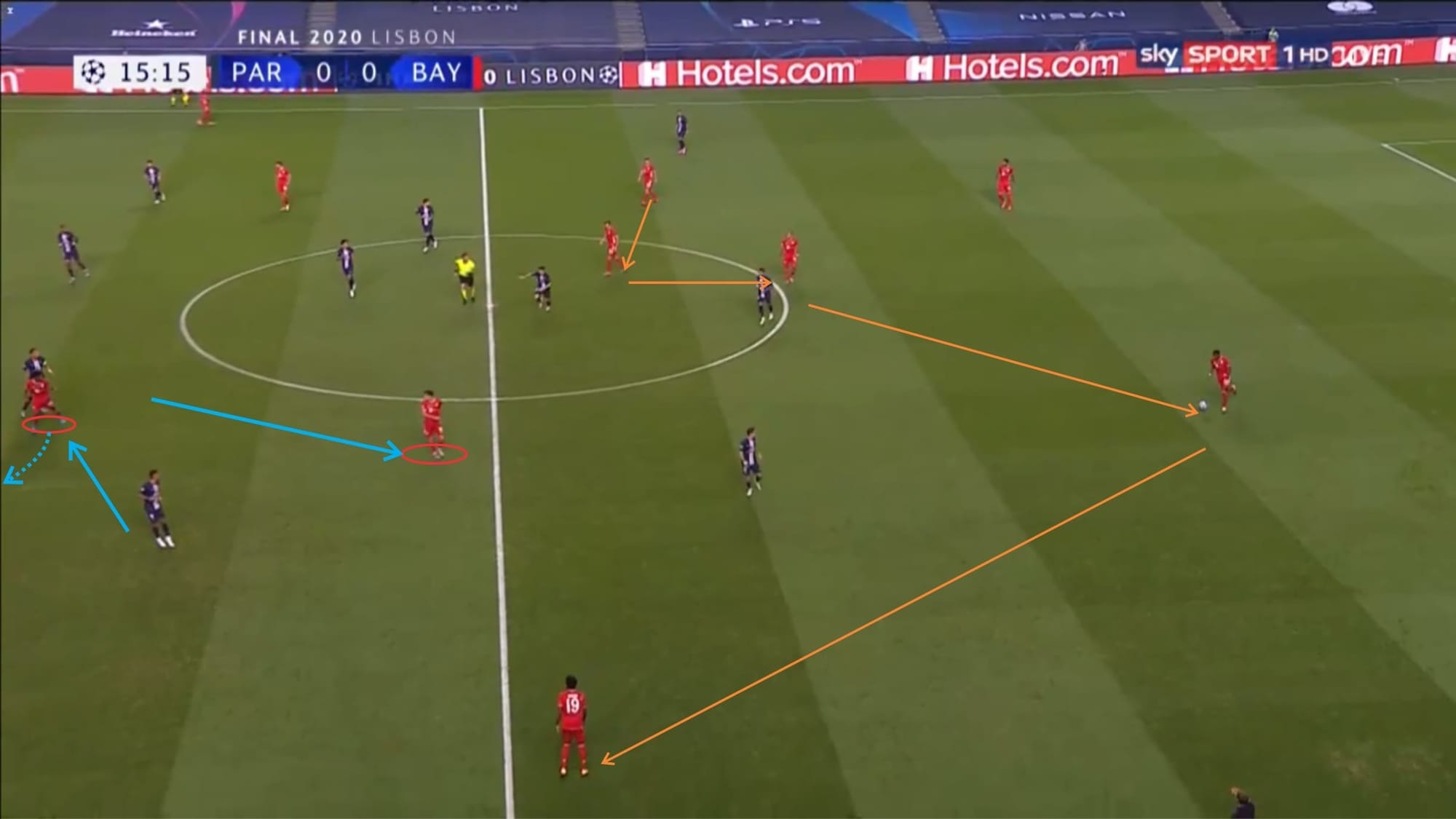
Bayern have quite a flexible approach in the attack. They’re not necessarily focused on attacking down the flanks nor do they solely penetrate central areas. Just like Sevilla, Bayern also like to utilise width to force the opposing team to shift their block in order to create vertical gaps. But aside from that, Bayern are also highly proficient in creating and exploiting horizontal gaps/gaps between the lines through combined movements.
Above you can see that Bayern were unable to make a clean vertical progression, and decided to shift their attack towards the other flank. The quick passing sequence to switch the play allowed Bayern to get the ball where they wanted it to be before PSG can shift their block and adjust their structure, thus creating gaps in the middle of the field.
The players in the red circle are Gnabry and Lewandowski. As can be seen above, Lewandowski dropped deep from his position and asked for the ball. Meanwhile, at the same time, Gnabry moved from occupying the right-back to occupying the centre-back, allowing Lewandowski to stay momentarily unmarked. Again, as mentioned above, creating confusion and dilemmas for the opposing defenders.
Bayern tend to have their players actively move, constantly attracting and occupying certain defenders in order to help free up their teammate.
Conclusion
Both teams are on a very strong form this year with Bayern winning almost every game they have throughout 2020, while Sevilla have been unbeatable since February. Bayern, however, already have at least one competitive game under their belt while Sevilla haven’t had any. There’s fear that Lopetegui’s side may lack sharpness, which may dramatically impact how they’ll perform in this game.
Despite that, there’s not any doubt that this will be a very exciting game both from the perspective of a regular football fan or as an analyst. We can certainly anticipate not only a battle of tactics but also a battle of hearts and will. Will the heavy favourites secure yet another trophy or will the dark horses end up with a surprise win? We shall see tomorrow.





Comments